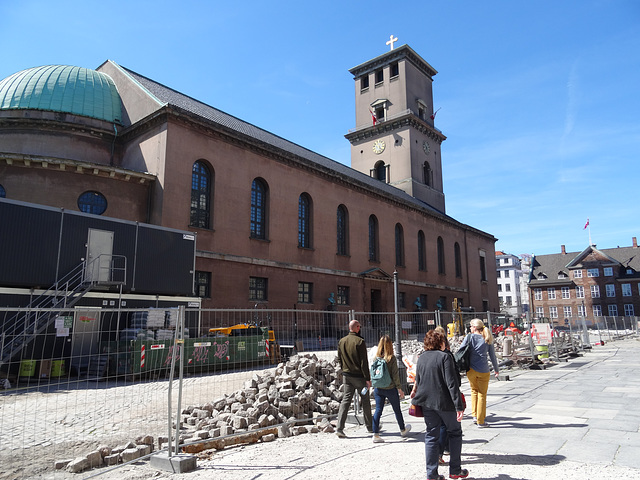The Round tower of Copenhagen again
1 (152)
1 (151)
Warm is a relative thing. Our young, local, tour g…
1 (147)
Market near the Norreport train station
1 (142)
A city of bicycles. Train station parking lot.
Old Telephone kiosk
Love the street ads here.
Day 2: Walking Tour starting point. Copenhagen's R…
Worn out and ready to go back to the hotel.
Flag of Denmark over the fortifications of Kronbor…
Gazing across the castle ramparts toward Sweden
1 (121)
The royal box in the chapel above the riff-raff
Decorative carving on a pew in the castle chapel
Holger Danske at Kronborg Castle, Denmark
The Knights Hall.
Depiction of Saturn devouring one of his sons, fol…
Kronborg Castle courtyard.
Kronborg Castle courtyard.
Gate to the courtyard
Front of Vor Frue Kirke, Our Lady Church. Site of…
1 (159)
The Supreme Court of Denmark
1 (164)
City Hall Tower
Copenhagen City Hall
upscale Scandic Palace hotel
Tivoli Garden building
Our tour guide instructs us on the history of the…
Lur Blowers statue, calling warrior Danes to battl…
Magstræde is one of the oldest streets in Copenhag…
Magstraede 18 is one of the oldest houses in Copen…
Supposedly, this ochre colored paint is somewhat u…
Tight turn on the canal tour
1 (183)
Christianborg Castle
1 (187)
Christianborg Castle is the seat of the Danish Par…
1 (192)
A small garden at Christianborg castle
1 (196)
1 (197)
See also...
Authorizations, license
-
Visible by: Everyone -
All rights reserved
-
123 visits
Vor Frue Kirke (Our Lady Church) Is associated with the University of Copenhagen. It's had an long and interesting history, beginning in the late 12th century .


Vor Frue Kirke (Our Lady Church) Is associated with the University of Copenhagen. It's had an long and interesting history, beginning in the late 12th century but the current building was completed in 1829, following a destructive fire, caused by the bombardment of Copenhagen by the British navy in 1807.
Here's bit from Wiki: The Protestant Reformation was hard on St Mary's. Citizens of Copenhagen had elected to follow Luther, but Catholic officials at St Mary's tried to maintain the church as a centre of Catholic resistance to change in Copenhagen. By royal decree both Catholic priests and Lutheran preachers were commanded to use the church jointly, which incensed the majority of Copenhagen's population. On 27 December 1530 hundreds of citizens stormed St Mary's, destroying every statue and dismantling the choir stalls. The 17 richly gilt altars were stripped of jewels and gold and smashed, as were reliquaries, vestments and altar equipment. Even the name "St Mary's" became "Vor Frue Kirke" (Our Lady's Church), keeping the historic reference to Mary without the use of the un-Lutheran "Saint" appellation. Just a year later Our Lady Church celebrated the acceptance of the Lutheran Order presided over by Johan Bugenhagen, an associate of Martin Luther. 1539 saw the installation of the first Lutheran superintendents, later bishops, of Denmark. In 1568 the dean of Our Lady Church was charged with defining accepted practice for Lutheran church services in Denmark under the direction of the Bishop of Zealand. Ever since, the dean (and later bishop) of Our Lady Church has carried out that role in the Danish National Church.
Here's bit from Wiki: The Protestant Reformation was hard on St Mary's. Citizens of Copenhagen had elected to follow Luther, but Catholic officials at St Mary's tried to maintain the church as a centre of Catholic resistance to change in Copenhagen. By royal decree both Catholic priests and Lutheran preachers were commanded to use the church jointly, which incensed the majority of Copenhagen's population. On 27 December 1530 hundreds of citizens stormed St Mary's, destroying every statue and dismantling the choir stalls. The 17 richly gilt altars were stripped of jewels and gold and smashed, as were reliquaries, vestments and altar equipment. Even the name "St Mary's" became "Vor Frue Kirke" (Our Lady's Church), keeping the historic reference to Mary without the use of the un-Lutheran "Saint" appellation. Just a year later Our Lady Church celebrated the acceptance of the Lutheran Order presided over by Johan Bugenhagen, an associate of Martin Luther. 1539 saw the installation of the first Lutheran superintendents, later bishops, of Denmark. In 1568 the dean of Our Lady Church was charged with defining accepted practice for Lutheran church services in Denmark under the direction of the Bishop of Zealand. Ever since, the dean (and later bishop) of Our Lady Church has carried out that role in the Danish National Church.
- Keyboard shortcuts:
Jump to top
RSS feed- Latest comments - Subscribe to the comment feeds of this photo
- ipernity © 2007-2025
- Help & Contact
|
Club news
|
About ipernity
|
History |
ipernity Club & Prices |
Guide of good conduct
Donate | Group guidelines | Privacy policy | Terms of use | Statutes | In memoria -
Facebook
Twitter

Sign-in to write a comment.